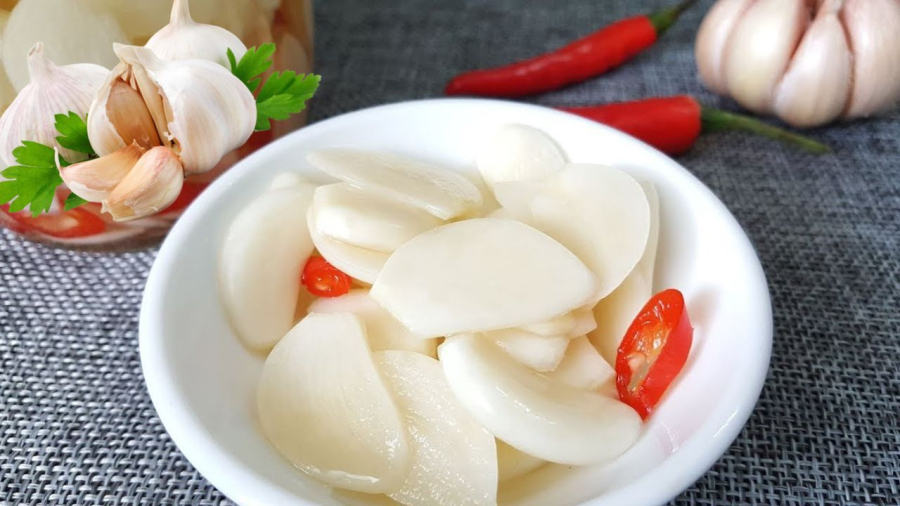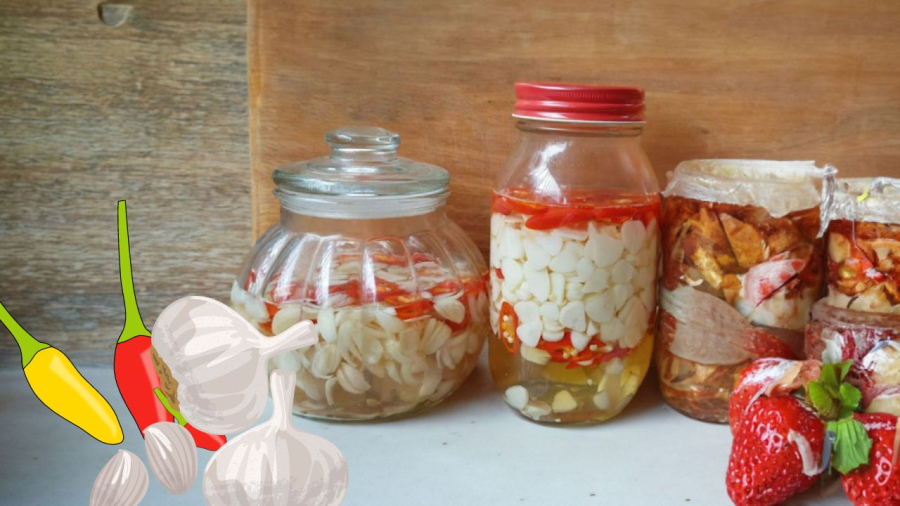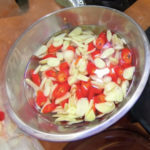Causes of Green-Color Garlic Pickle
Garlic pickled in vinegar is very familiar and easy to make, but many pickle jars turn green the next day, which is very unappealing.
The cause of garlic turning green is oxidation. This is mainly due to young garlic and garlic with a lot of allicin, so when exposed to air and vinegar, they undergo oxidation reactions and form a green color. Therefore, when making garlic pickled in vinegar, it is necessary to know how to handle and prepare the garlic to overcome this issue.

Green garlic is caused by young garlic or garlic that has not been properly cleaned
Preparing Ingredients for Garlic and Chili Pickling
Choose 200g of garlic or more depending on the size of your family and the amount of pickle you want to make. If you want the pickled garlic to be crispy and white, choose old and firm garlic bulbs. Small garlic cloves taste better than large ones, but peeling and preparing them takes longer. Garlic with purple skin tastes better than garlic with white skin, and a single clove garlic tastes better than multiple clove garlic.
Use 500ml or more of vinegar depending on the quantity of garlic. There are many types of vinegar available on the market. You should choose high-quality vinegar that is not dark and has a refreshing taste. Cheap vinegar is very dark and has an unpleasant taste.
Fresh chili peppers
Salt
Water
Glass jars or porcelain jars. Avoid pickling garlic in plastic jars as they can react negatively.

Properly preparing garlic will make the pickled garlic crispy, white, and not turn green
Preparing Garlic to Avoid Turning Green
In addition to choosing good quality garlic, the preparation of garlic is very important to avoid turning it green.
Peel and slice the garlic cloves to a suitable size. Wash the garlic thoroughly and soak them in a diluted saltwater solution with a little sugar for about 30 minutes. Then drain the water and soak the garlic again to remove any green color. Soaking the garlic multiple times helps reduce the allicin content, so it will not turn green. You can soak the garlic 2-3 times in cold water to make the pickled garlic avoid turning green.
To prevent bacterial contamination and avoid the pickled garlic from turning soft, you can blanch the garlic in boiling water for a quick moment and then let it drain.
Wash the chili peppers thoroughly, remove the seeds, and slice them. The amount of chili peppers depends on the preference for spiciness in your family. You can add chili peppers or not, depending on your family’s taste.
Boil the vinegar with water and add a little sugar to make it boil and dissolve. You can skip the boiling step, but boiling the vinegar helps eliminate any unpleasant odor and prevents white residue in the pickling solution. Adding sugar makes the vinegar taste better and speeds up the pickling process. You can choose to pickle directly with 100% vinegar without adding water, and add sugar.
Pickling Garlic in Vinegar:
After the garlic has drained, put it in a glass jar. Remember to rinse the glass jar with boiling water and let it drain. Place the garlic and chili peppers in the glass jar.
Pour the cooled vinegar solution into the jar with garlic and chili peppers. Seal tightly and store in a cool place. After 2-3 days, the pickled garlic will be ready to eat. Avoid leaving the jar of pickled garlic in a hot place or in direct sunlight, as it will quickly become sour and the garlic will not stay crisp.
When serving, use a clean spoon to scoop out the pickled garlic to avoid creating bubbles by using the spoon you are eating with directly in the jar of pickled garlic.
































